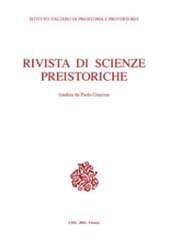Aspetti di metallurgia dell'età del Rame 3 al Pigloner Kopf (BZ)
P. 1-31
The cult site Pigloner Kopf (BZ) belongs to a (pre-)bell-beaker chronological horizon and is dated through 14C to the second half of the 25th and/or 24th century BC. 11 out of 27 recognisable finished objects and 4 out of 20 small copper fragments (drips, drops, residues) were analysed by light microscopy, SEM-EDS, EPMA and LIA. The majority of the objects analysed, four out of four of the shaft-hole axes and two out of two of the awls, the only pin, and in addition four out of four of minute copper fragments analysed come with certainty from the Eastern Alps (Eastern Alps: Southalpine AATV). The presence of crucibles and copper drops also demonstrates the casting of copper (objects) on site. In addition to South Alpine copper, at least three other types of copper were in circulation at the Pigloner Kopf: one from the Apuan Alps (dagger), one from Ligura ('chisel' or butt of flat axe) and the third probably from Central Europe/Erzgebirge (pendant and helix spiral). [Publisher's text]
Il luogo di culto Pigloner Kopf (BZ) appartiene ad un orizzonte cronologico (pre-)campaniforme ed è datato tramite 14C alla seconda metà del XXV e/o al XXIV secolo a.C. Sono stati analizzati con microscopia ottica, SEM-EDS, EPMA e LIA 11 su 27 oggetti finiti riconoscibili e 4 tra i 20 piccoli frammenti (colature, gocce, residui) in rame. La maggioranza degli oggetti analizzati, quattro su quattro delle asce ad occhio e due su due delle lesine, l'unico spillone, e in più quattro su quattro dei frammenti minuti di rame analizzati provengono con certezza dalle Alpi Orientali (Eastern Alps: Southalpine AATV). La presenza di crogioli e di gocce di rame, inoltre, dimostra la fusione di (oggetti in) rame sul posto. Oltre al rame sudalpino, almeno altri tre tipi di rame erano in circolazione al Pigloner Kopf: uno proveniente dalle Alpi Apuane (pugnale), uno dalla Liguria ("scalpello" o tallone di ascia piatta) ed il terzo probabilmente dall'Europa centrale/Erzgebirge (pendaglio e saltaleone). [Testo dell'editore]
-
store_in_same_fr
-
information
doiCode: 10.32097/1264
issn: 2282-457X
KEYWORDS
- Età del Rame, asce ad occhio, archeometallurgia, analisi isotopiche del piombo
- Copper Age, shaft-hole axes, archaeometallurgy, Lead Isotope Analysis


